Today’s post was contributed by Marco Langbroek, based in Leiden, the Netherlands, and provides an excellent, in-depth guide to non-technical folks on how you, too, can capture ATV-4 in orbit this week! Thank you, Marco, for an excellent post! – Ed.
ESA’s supply ship ATV Albert Einstein will be launched on June 5th from Kourou, French Guyana, and will dock to the International Space Station on June 15th.
Meanwhile, it will spend 10 days in free flight where you will be able to see it pass in the night sky, approaching the ISS during the final few orbits. NW-Europeans will have a prime sighting opportunity a mere 20 minutes after launch. Still attached to the Ariane upper stage and still in a very low orbit, it will zip through the European skies just after midnight (CEST) of June 5/6. [See amended comment from ML here- Ed.]
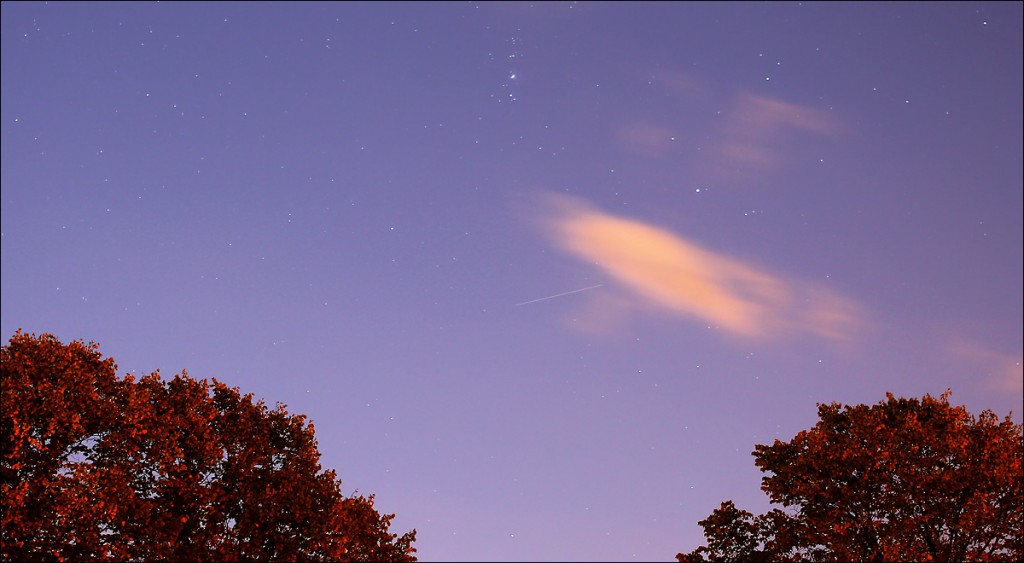
ATV-3 captured by Marco Langbroek after undocking from the ISS and shortly before reentry in the morning twilight of 30 September 2012. Canon EOS 60D + EF 2.0/35mm at F/2.5, 400 ISO, 5 seconds. The lower part of the constellation Orion is recognizable.
Wouldn’t it be nice to capture that in a picture? !
Well, you can. You don’t need fancy equipment to make a decent picture of the ATV passing amongst the stars. A standard compact camera or a standard DSLR will do well. This blog post will give you some tips on how to best see and photograph the ATV.
How to see and photograph it
The spacecraft usually is easily visible to the naked eye, even from an urban environment. At a maximum brightness of magnitude +1, it can be slightly brighter than the brightest stars of the Big Dipper and similar in brightness to Deneb and Altair, two bright stars in the summer triangle. How bright it exactly is at any given time, however, strongly depends on the geometry of the observer with regard to the spacecraft.
As a result of being quite bright, ATV-4 is not too difficult to photograph if you know how to do it properly.
The ‘properly’ is important here: there are some ‘tricks to the trade’ you need to know. Making photographs of the night sky is different from everyday photography. For example, you are going to use much longer exposure times than normal – up to several seconds of exposure time! The lens/camera settings will also be critical.
The good news: you don’t need fancy equipment. A standard compact camera or a standard DSLR will do well. Of course, if you have a DSLR it will give you a bit more opportunity to select a suitable lens and play with suitable camera settings: all of which will be explained below.
It’s all in the planning
Making a good photograph is however not just about equipment, but also about planning. You’ll have to know when, and where in your sky, the ATV will pass. This will be outlined later in this post, under “When and where to look?” Being prepared with pass predictions means you’ll be ready, waiting with your camera aimed, focussed and properly set, minutes before the ATV will pass.
Basic rules of equipment
Of course you need a camera. Almost any modern camera will do: a compact camera, or a DSLR if you have one. Camera-phones are generally not so suitable though (although you might try).
First basic rule: put your camera on a tripod. This is mandatory. Photographs taken out of the hand will not do: you will be using long exposures times, and the images will get blurred by camera shake if you attempt pictures without a tripod.
If you don’t have a tripod, fill a medium-sized bag 2/3rds full with rice or dry beans and use it to stabilize your camera – just put the camera on the filled bag. It will however be less easy to aim your camera.
Second basic rule: put your camera on manual operation, not automatic. We are going to choose our camera settings ourselves, and not let the camera do it. For DSLR’s, this includes putting the lens on manual focus too. Autofocus will not work under low light level conditions, so you’ll have to focus manually.
Third basic rule: use a remote control/wire release (DSLR) or use the timer option (compact and DSLR). The act of pressing the exposure button on the camera itself might result in camera shake with the kind of long exposures you are going to use. Setting the timer option to 2 seconds will allow your camera to get stable again after you press the button: if you have a DSLR, using a wire release/remote control is even better as you then do not have to touch the camera at all.
Fourth basic rule: use no flash! Disable it, especially on a compact camera (Advanced photographers can, however, use it to lighten the foreground, if they know how to do that. Otherwise, don’t use the flash.)
What follows below is a guide on how to set and operate your camera, depending on whether it is a compact camera or a DSLR. Next, some further general tips are given, and I will tell you how to predict ATV passes in advance, allowing you to carefully prepare your photography.
Using a compact camera
First, make sure you have read and taken in the four basic rules of equipment outlined in the previous section of this post. Especially make sure you have disabled the flash.
For a nice shot of the starry sky with the ATV zipping through it, you’re best to put your compact on wide angle (widest field). Put your autofocus on “off” – under night time conditions your camera will have difficulty reaching focus and images would likely come out un-sharp. Your camera should have an option to preset it on “infinite focus” (on Canon compacts this is the “mountain” symbol). Do so.
In order to capture stars and the ATV in the image, the camera has to be set to a sensitive ISO setting. ISO 400 is a good setting (in twilight you might want to tone the ISO setting down though). Higher ISO settings however also mean that your images will show more noise (‘grain’), and that is where a compact is usually at a disadvantage compared to a DSLR. Before you go hunt for the ATV, make a few test images of the sky to determine at which ISO setting you find the noise level to be still acceptable.
If you can set the aperture value of the lens, set it to the largest lens opening (this is the smallest numeric aperture value, often 2.8 on a compact). This allows the camera to gather as much light as possible.
Use the timer option and set the delay to 2 seconds. This will mean the exposure starts 2 seconds after you pressed the camera button, allowing the camera to stabilize from camera shake caused by pressing the button.
Depending on your surroundings (e.g. a city or a rural area), you want to use exposure times between 10 and 30 seconds. Before you go hunt for the ATV, make a few test images of the sky to see how long an exposure is viable before the image fogs. The same goes for photography in twilight: test the best settings a few minutes before the ATV passes. In an urban environment, stick to exposures no longer than 10 seconds or (if light pollution is severe) less.
Don’t use a too short an exposure. An exposure of say 1/100th of a second will show you very little! Stars and the ATV are relatively faint for your camera, so it needs a longer exposure to capture them.
Some compacts make a “dark frame” after a long exposure. They do this to get rid of hot pixels and excessive noise in the image: the “dark frame” is substracted from the actual exposure by the camera software. Taking the dark frame takes as long as the actual exposure, so a 20 second exposure will be followed by a 20 second “time-out” where the camera is inoperable because the camera is making the dark frame. If you want to take multiple pictures during a pass, don’t use too long exposures for this reason.
Using a DSLR
First, make sure you have read and taken in the four basic rules of equipment outlined earlier in this post.
For a nice shot of the starry sky with the ATV zipping through it, you had best use a wide-angle lens on your DSLR. Anything between 24mm and 50mm will do for a 1.6 crop factor DSLR; personally I choose a 35mm lens for ATV and ISS shots.
You will generally get the best image quality by using a “prime” lens (a lens with a fixed focal length, e.g. 35mm) instead of a zoom lens. The image quality of a zoom is always somewhat worse than that of a prime and with astrophotography this quickly becomes apparent. Of course, if you only have a zoom lens, then use the zoom lens. But if you have a 28mm, 35mm or 50mm prime, use it in preference over a zoom lens.
Use a fast lens. A fast lens is one with a relatively large lens opening, which means it gathers as much light as possible. The indicator of a fast lens is the F/ value listed on the lens: e.g. F/2.8, 3.2, 4.0, 5.6 (to name a few common values). Use one with a low value: 1.8, 2.8, 3.0. Lenses with a F/ value over F/3.5 are not so suitable.
Set the DSLR to “manual” (usually the “M” setting). Set the exposure to anywhere between 10 and 30 seconds, depending on how dark your sky is. Set the lens aperture (the F/ value) to the lowest possible value: this translates to the lens full open. This means if you use an F2.8/28 mm lens, set it to F/2.8, and not to large values like F/16. In some cases you might, however, want to stop the lens one stop down (e.g. to F/3.2 instead of F/2.8), depending on the quality of your lens, as this one stop might improve the image sharpness.
The lens should be put on manual focus, not autofocus. On Canon cameras (which I use myself) this is done with a switch at the lens: put it to “M”. Autofocus will not work under night time conditions.
You’ll have to manually focus your camera. Do this by putting the camera on “live view” if your camera has that option. Point it to a bright star. Zoom in maximally on the LCD screen (on a Canon EOS you do this with the “+” button at upper right). Then focus until the star is as pinpoint on the LCD screen as possible. After that, take care to not touch the focus ring any more!
Note that on modern motor-focus lenses, setting the lens to the “infinite” sign usually will not suffice to get sharp images of a starry sky.
If your camera does not have “live view” then getting accurate focus becomes quite problematic. You might try (well before the ATV pass!) to make a series of test images until you are satisfied with the focus. Or you might try to focus on an object at large distance (several kilometres away, ideally) in daytime, and fix the focus ring with a piece of tape (don’t forget to put the lens on “manual” after that!).
Use an exposure time of several seconds. I usually use 10 seconds with a 35mm or 50mm lens. Before you go hunt for the ATV, make a few test images of the sky to see how long an exposure is viable before the image fogs due to light pollution. The same goes for photography in twilight: test the best settings a few minutes before the ATV passes. In an urban environment, stick to exposures no longer than 10 seconds or (if light pollution is severe) less.
Use the timer option and set the delay to 2 seconds. This will mean the exposure starts 2 seconds after you pressed the camera button, allowing the camera to stabilize from camera shake caused by pressing the button. Alternatively (and much better) you can use a wire release or remote control, if you have one.
Set the ISO value (the sensor sensitivity) to anywhere between 400 and 1000. For a bright object like ATV and with a fast 2.8 lens, ISO 400 to 800 usually will do. In twilight, you might however want to tone the ISO setting down a notch, to 200 or even 100.
When and where to look?
Of course, when you want to see or photograph the ATV you first have to know where and when to look. Preparing your observation in advance will be crucial if you aim to get a good picture of it. You should be waiting with your camera ready, focussed and aimed!
This means you must have pass predictions available. Luckily, ESA has made orbital elements for the various stages of the flight available here: https://blogs.esa.int/atv/2013/06/02/finding-atv-in-the-sky/
I expect several on-line pass prediction generators such as heavens-above (www.heavens-above.com) or Calsky (https://www.calsky.com) to have predictions available, based on these orbital elements, from June 5 onwards.
On such websites, just put in the coordinates of your town, select the ATV-4 vessel, and it will give you pass predictions and a sky map.
Advanced prediction
If you are handy with astronomical software, you can generate predictions yourself too. This is more advanced and therefore perhaps not for everybody. Still it is not that complicated either and free and simple software is available on the internet.
Start with downloading Heavensat (https://www.heavensat.ru/english/), which is free software enabling you to generate your own satellite pass predictions from a set of orbital elements. Provide the program with your observing site coordinates and load the relevant ATV orbit set (put the three data lines corresponding best to the date and time you want to observe in a .txt file and load that file in Heavensat. In other words, if you observe in the evening of June 6-7, use the orbit set #2013/06/07 00:00:43.517). You will now be able to generate pass predictions, and have the program produce a map of the trajectory amongst the stars as well!
Tip: play around a bit with Heavensat so you know how to operate it well before you start to look for the ATV.
During the final orbits just before docking, the ATV will start to approach the ISS and the two of them can be seen close together in the sky if you are lucky. Orbital elements for the ISS can be found here: https://celestrak.com/NORAD/elements/ Look under “Special Interest Satellites” and then “space stations”: the element set “ISS (Zarya)” is the International Space Station. Sites like heavens-above will also provide you with ISS pass predictions.
(So will the ATV blog – Ed.)
Aiming your camera
Now that you know where the ATV will pass, you can point your camera a few minutes in advance and actually plan at which part of the sky to point. A pattern of bright stars in the field makes for a nice starry background and helps in aiming your camera, so use your predicted sky track to find a part of the pass where the ATV will pass through an easily seen group of stars.
A nice foreground makes for an attractive picture. So see whether you can photograph the ATV sailing over some nice trees or a nice building.
Star trails and satellite trails, and my preferred settings and lenses
Using a several-second exposure will result in slightly trailed stars, not pinpoint stars. This is because the Earth (and as a result the starry sky) rotates notably in even a few seconds time. When you use a 10-second exposure and a 28mm, 35mm or 50mm lens, the stars will still look more-or-less pinpoint in a full-image view. The star trails will only become notable when you zoom in deeply on the image.
The satellite will also produce a trail, as it moves across the sky. With a 10-second exposure, the satellite trail will be much longer than the star trails, so it will stand out clearly on your image.
So why then not use a very short exposure and have both the stars and the ATV pinpoint? One reason is that as a point of light, the ATV will not stand out amongst the stars. With a trailed image, it is instantly recognizable. In my opinion, images with very short star trails and a longer satellite trail make for the more attractive images as the satellite is much more, and much more instantly, recognizable. This is one reason why I use a 10-second exposure as a rule.
A similar argument can be made about too-long exposures (e.g. 30 seconds or a minute). Apart from the need for a very dark sky (I photograph from Leiden town centre, where anything over 10 seconds will result in strongly fogged images from light pollution), I find images where both star trails and the satellite trail are very long, and images where the satellite trail crosses the full image from border to border, not so attractive. That is a personal taste however, so it is up to you!
I currently use a Canon EOS 60D for my photography, and previously used a Canon EOS 450D (and in more remote times, a Canon Ixus compact). For objects in a low-earth orbit such as the ISS and the ATV, I use a 35mm or 50mm lens. These have a field of view of 24 x 18 degrees (50mm) and 33 x 25 degrees (35mm) respectively. This allows you some point-and -error leeway and the possibility to capture recognizable constellations of stars in your image.
In some cases I might chose to use a lens with an even wider field of view, e.g. a 24mm or 17mm lens. This is a choice you can make when for example the ISS and ATV are approaching each other and they can be seen in the sky at the same time, but still too large a distance apart to get them in one image with a 35mm lens.
Some common mistakes not to make
There are several common mistakes made by first-time satellite photographers. While some have already been covered in the previous sections of this post, I will reiterate a few just to be clear, as I see these errors made time and time again:
a) Using a too-large value for the aperture setting (e.g. F/11 or F/16). In normal daylight photography you do this because it reduces lens flaws and makes for a more forgiving depth of field, resulting in somewhat sharper images. In our case however, stopping down the lens too much means you lose valuable light. You risk that stars and the ATV will appear dimly in your image, or will not even be visible at all. Use F/1.8, F/2.8 or F/3.2 instead. If you have concerns about the image quality, you might opt to stop the lens down one stop (e.g. from F/2.8 to F/3.2) but no more.
b) Using a too-low an ISO setting (e.g. ISO 100 or 200). Again, this will result in stars and the ATV looking dim. Use ISO 400 to ISO 1000 depending on how your camera performs with regard to noise at higher ISO. Only in twilight you might use an ISO 100 or 200 setting.
c) Using too-short exposure times. Too short and you will see either nothing on your image, or the ATV will not stand out in the image well.
d) Images not properly focussed. Note that on modern lenses, setting the lens to the “infinite” sign usually will not suffice to get sharp images of a starry sky.
e) Camera vibrations. Take care to put your tripod on a sturdy surface, and don’t touch it or the camera or jump around close to it when the camera is making an exposure. Also take care that a wire release is not swinging during the exposure. I often see images with wobbly sinusoid trails because the photographer touched the tripod or walked around close to the tripod during an exposure causing vibrations. Also beware of cats hugging your tripod 😉
After-editing of images
I almost listed this one in the previous section, as a commonly made mistake. Too many people present their pictures “as is”, the way they came right out of the camera, without any after editing. Usually these pictures are rather dull in contrast and colour, and often the colour balance is off. The latter is an almost inevitable effect of long exposures under night time conditions.
The solution: after-editing of the images in a good image editor, e.g. Photoshop, Lightroom, Paint Shop Pro or GIMP. This allows you to readjust the colour balance, put some more contrast in your images, perhaps reduce the noise, and even improve the sharpness. I strongly recommend you to spend some time after-editing your images, as your imagery will dramatically improve in quality.
If you save your images as JPG, make sure not to use too strong a compression factor. Stars and satellite trails quickly get ugly due to compression artefacts.
If you reduce your images in size (e.g. in order to post them on the internet), don’t forget to subject the reduced images to an unsharp mask to regain some sharpness.
Now let the fun begin!
Good luck with chasing the ATV, and share some of your imagery if you do capture it!
Examples
Image 1: ATV-3, the previous ATV launch, captured by the author along with a second satellite, the US military satellite FIA Radar 1, on 28 March 2012 from his home in the center of Leiden, the Netherlands. The trail of the military satellite is shorter because it passed at a much higher altitude than the ATV. Canon EOS 450D + EF2.0/35mm lens, 800 ISO, 10 seconds.
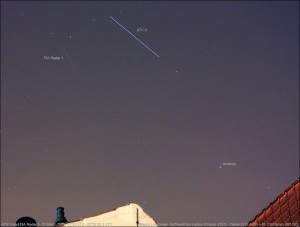
ATV-3 captured by Marco Langbroek along with a second satellite, the US military satellite FIA Radar 1, on 28 March 2012 from his home in the centre of Leiden, the Netherlands. The trail of the military satellite is shorter because it passed at a much higher altitude than the ATV. Canon EOS 450D + EF2.0/35mm lens, 800 ISO, 10 seconds.
Image 2: ATV-3, the previous ATV launch, captured by the author just 20 minutes after launch in deep morning twilight of 23 March 2012. It was still attached to the Ariane Upper Stage at that time. Canon EOS 450D + EF2.8/24mm lens, 400 ISO, 4 seconds.
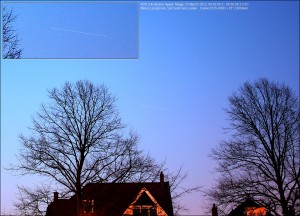
ATV-3 captured by Marco Langbroek just 20 minutes after launch in the deep morning twilight of 23 March 2012. It was still attached to the Ariane Upper Stage at that time. Canon EOS 450D + EF2.8/24mm lens, 400 ISO, 4 seconds.
Image 3: ATV-3, the previous ATV, captured by the author after undocking from the ISS and short before reentry in morning twilight of 30 September 2012. Canon EOS 60D + EF 2.0/35mm at F/2.5, 400 ISO, 5 seconds. The lower part of the constellation Orion is recognizable.

ATV-3 captured by Marco Langbroek after undocking from the ISS and shortly before reentry in the morning twilight of 30 September 2012. Canon EOS 60D + EF 2.0/35mm at F/2.5, 400 ISO, 5 seconds. The lower part of the constellation Orion is recognizable.
Image 4: ATV-3, the previous ATV launch, captured by the author in deep morning twilight of 24 March 2012. Canon EOS 450D + EF2.8/24mm lens, 400 ISO, 10 seconds.
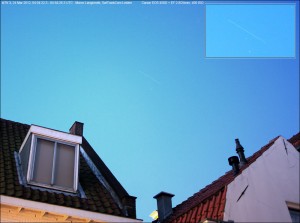
ATV-3 captured by Marco Langbroek in the deep morning twilight of 24 March 2012. Canon EOS 450D + EF2.8/24mm lens, 400 ISO, 10 seconds.
Image 5: ATV-3, the previous ATV launch, captured by the author on 27 March 2012. Canon EOS 450D + EF 2.5/50mm Macro, 800 ISO, 6 seconds.
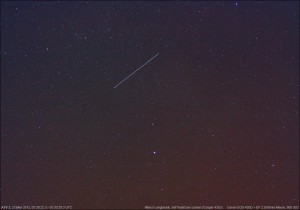
ATV-3 captured by Marco Langbroek on 27 March 2012. Canon EOS 450D + EF 2.5/50mm Macro, 800 ISO, 6 seconds.
Image 6: ATV-1, the first ATV, and the International Space Station close together in one image, 31 March 2008. Canon Digital Ixus 75 compact camera, 400 ISO, 10 seconds
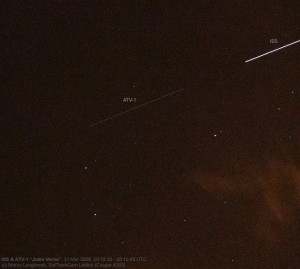
ATV-1 and the International Space Station close together in one image, 31 March 2008. Canon Digital Ixus 75 compact camera, 400 ISO, 10 seconds

 Automated Transfer Vehicle page
Automated Transfer Vehicle page ATV blog archive
ATV blog archive
Discussion: 2 comments
A note. When I wrote:
“NW-Europeans will have a prime sighting opportunity a mere 20 minutes after launch. Still attached to the Ariane upper stage and still in a very low orbit, it will zip through the European skies just after midnight (CEST) of June 5/6”
…I might have misjudged the effect of its still very low altitude, 20 minutes after launch from Kourou. There is a possibility it will still be in earth shadow (see indeed the statement in the post here: https://blogs.esa.int/atv/2013/06/03/finding-atv-in-the-sky-ground-track-sky-chart/ ) even though for the Netherlands the sun is at only -12 degrees elevation (and will be even less in the UK). I can’t really judge that as the first orbit given is only for the next orbit, after upper stage separation, when the ATV orbital altitude is already higher (and I initially used that orbit for an assessment, having overlooked it was a post-separation orbit).
In 2012 I did see ATV-3 pass 20 minutes after launch but that was with a sun elevation of only -7, so deeper in twilight.
As mentioned in the blog post referenced earlier in this comment, the next orbit (around 01:46 CEST) will be perfect though, with ATV-4 passing through the zenit for the UK, Netherlands and Germany (with the sun at -15 degrees, so a dark starry sky).
I’ve just spent a few time trying to follow your advices, but I was able to photograph just stars not the ATV..:(